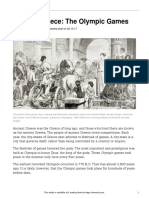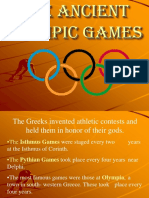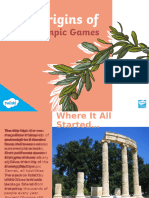British Museum Olympic Games
British Museum Olympic Games
Uploaded by
losplanetasCopyright:
Available Formats
British Museum Olympic Games
British Museum Olympic Games
Uploaded by
losplanetasCopyright
Available Formats
Share this document
Did you find this document useful?
Is this content inappropriate?
Copyright:
Available Formats
British Museum Olympic Games
British Museum Olympic Games
Uploaded by
losplanetasCopyright:
Available Formats
A
The Olympic Games in Ancient Greece
Information for Teachers
Learning & Information Department Telephone +44 (0)20 7323 8511/8854 Facsimile +44 (0)20 7323 8855 education@thebritishmuseum.ac.uk
Great Russell Street London WC1B 3DG Switchboard +44 (0)20 7323 8000 www.thebritishmuseum.ac.uk
The Olympic Games in Ancient Greece The sporting events at Olympia were the oldest and most important of the four national Greek athletic festivals. The games were held on an official basis every four years from 776 BC, but they probably originated much earlier. Greek myth credited the hero Herakles with devising the running races at Olympia to celebrate the completion of one of his twelve labours. Olympia was the most important sanctuary of the god Zeus, and the Games were held in his honour. Sacrifices and gifts were offered, and athletes took oaths to obey the rules before a statue of Zeus. The games were announced by heralds travelling to all the major Greek cities around the Mediterranean, and hostilities were banned during the period around the Games to safeguard those travelling to and from Olympia. The games at Olympia continued with minor interruptions into early Christian times and were the inspiration for the modern Olympic Games, first staged in Athens in 1896.
Archaeology at Olympia Over the centuries the river Alpheios, to the south of the sanctuary, folded and swept away the hippodrome, and the river Kladeios to the west destroyed part of the gymnasium. Following earthquakes and storms, a layer of silt was deposited over the entire site. Olympia lay unnoticed until modern times when an Englishman, Richard Chandler, rediscovered it in 1766. The German government sponsored full-scale excavations from 1875. The excellent local museum displays many of the remarkable finds, and the German Archaeological Institute in liaison with the Greek Archaeological Service continues to investigate the site to the present day.
Equestrian Events
In ancient Greece only the wealthy could afford to maintain a chariot and horses. Chariots had been used to carry warriors into battle, and chariot races, along with other sports events, were originally held at the funeral games of heroes, as described in Homers Iliad. Wealthy citizens and Greek statesmen were anxious to win such a prestigious event. They sometimes drove their own chariot, but usually employed a charioteer. The races took place in an arena called the hippodrome. The most dangerous place was at the turning post, where chariot wheels could lock together and there were many crashes. After the dangers and excitement of the chariot race came the horseracing. This was hazardous because the track was already churned up, and the jockeys rode without stirrups or saddles, which were not yet invented. The winning horse and its owner were given an enthusiastic reception, and riderless horses that came first past the post were also honoured. 4
Combat Sports A big attraction at all the Greek games were the heavy events wrestling, boxing, and the pankration, a type of all-in wrestling. Specialists in the sports could win large sums of money all over the Greek world, once they had proved themselves at Olympia. Wrestling was a sport of great skill which used many of the throws still seen today. It also featured as part of the pentathlon. Boxing was considered the most violent sport. There were no separate rounds in a match and the contestants fought until one of them gave in. In ancient Greece thin strips of leather were bound around the boxers fists to protect their hands. Boxing gloves were eventually developed, and in the Roman period they were weighted with lead or iron to inflict greater damage. The pankration was a mixture of boxing and wrestling, where almost any tactic was permitted. Only biting and going for an opponents eyes were illegal.
Running Events
The most ancient and prestigious event at Olympia was the running race along the length of the stadium, a distance of 600 Olympic feet (192.28 metres). The Olympiad (the four-year period up to the next Games) was named after the winner, and dates were recorded by reference to the list of victors. Besides this equivalent of our two-hundred metre event, there was a race along two lengths of the track, and a long-distance race of twenty or twenty-four lengths. There was no marathon this was the invention of Baron de Coubertin who revived the Olympic Games in 1896. In all these races the runners made a standing start, from a row of stone slabs set in the track that had grooves cut in them to provide a grip for the toes.
Pentathlon The pentathlon was made up of five events discus, jumping, javelin, running and wrestling which all took place in one afternoon. Running and wrestling also existed as separate events. There are differences between the ancient and the modern contests. Greek discus-throwers did not spin round on the spot: they rarely managed throws of more than 30 metres, less than half the modern Olympic record. In the ancient long-jump, contestants used jumping-weights. These where swung forward on take-off then backward just before landing, to add thrust and gain extra length. Some kind of multiple jump may have been involved. Javelin-throwing was similar to todays event, except that a thong was attached to the javelin shaft to add spin and secure a steadier flight.
The Programme of Events Day One Morning: Swearing-in ceremony. Contests for heralds and trumpeters. Boys running, wrestling and boxing contests. Prayers and sacrifices in the sanctuary of Zeus; consultation of oracles. Afternoon: Speeches by philosophers, poets and historians. Tours of the sanctuary of Zeus. Reunions with old friends. Day Two Morning: Procession in the hippodrome of competitors in the equestrian events. Chariot and horse-races. Afternoon: The pentathlon. Evening: Funeral rites in honour of the hero Pelops. Parade of vistors around the sanctuary of Zeus. Singing of victory hymns. Feasting and revelry. Day Three Morning: Procession of the judges, ambassadors, competitors, and sacrificial animals to the Great Altar. Afternoon: Running races. Evening: Public banquet in the Prytaneion. Day Four Morning: Wrestling event. Midday: Boxing and the pankration (all-in-wrestling). Day Five Procession of victors to the Temple of Zeus, to be crowned by the judges with garlands of wild olive.
The Olympic Victors Valuable prizes could be won in athletic contests all over the Greek world, but victory at Olympia brought the greatest prestige. Winning contestants were allowed to put up statues of themselves inside the sanctuary of Zeus to commemorate their victory; many bases for these statues survive. Statues of athletes and statesmen were a prominent feature of Greek cities and sanctuaries. Athletes tied a woollen band around their forehead, and sometimes around their arms and legs, as sign of victory. Winners at Olympia received crowns of wild olive, just as Herakles was said to have done when he had run the first races at Olympia with his brothers. In this scene he receives a garland from Nike, the goddess of Victory. With them is Herakles father, Zeus, holding a thunderbolt, his symbol of power.
Further information Judith Swaddling, The Ancient Olympic Games (BM Press, 8.99) Richard Woff, The Ancient Greek Olympics (MB Press, 8.99)
Related displays
Room 69: cases 18, 19, 24 Room 84: discus-thrower
You might also like
- The Story of The Olympic GamesDocument19 pagesThe Story of The Olympic Gamesmilanko8ratkovi8100% (2)
- History of The First Ancient Olympic GamesDocument6 pagesHistory of The First Ancient Olympic GamesDon J Asuncion100% (1)
- British Museum Olympic GamesDocument9 pagesBritish Museum Olympic GamesadimarinNo ratings yet
- Origin and Historical Evolution of Sports As A Common European Cultural Activity Author European CommissionDocument41 pagesOrigin and Historical Evolution of Sports As A Common European Cultural Activity Author European CommissionShinbeeNo ratings yet
- The Ancient Greek OlympicsDocument8 pagesThe Ancient Greek Olympicshenrymcdonald744No ratings yet
- Health Education 04012017Document50 pagesHealth Education 04012017Vignesh CoolNo ratings yet
- The Olympic Games of The AntiquityDocument3 pagesThe Olympic Games of The AntiquityRishu SinghNo ratings yet
- Adp H&pe 2nd Semester Ancient OlympicsDocument3 pagesAdp H&pe 2nd Semester Ancient Olympicstehzinaslam9597No ratings yet
- History of Athletics and Olympic GamesDocument33 pagesHistory of Athletics and Olympic GamesNadine RevillaNo ratings yet
- Ancient Olympic GamesDocument3 pagesAncient Olympic GameskariricalebNo ratings yet
- The Oldest Myth Which Concerns The Beginning of The Olympic Games Is That of Idaios Daktylos HeraklesDocument4 pagesThe Oldest Myth Which Concerns The Beginning of The Olympic Games Is That of Idaios Daktylos HeraklesLBORSI19100% (1)
- ESSAYDocument2 pagesESSAYЈефимија ЈовановићNo ratings yet
- The OlympicsDocument5 pagesThe OlympicsDrago ŠarićNo ratings yet
- The Story of The Olympic GamesDocument19 pagesThe Story of The Olympic GamesEvelinaNo ratings yet
- The Story of The Olympic GamesDocument19 pagesThe Story of The Olympic GamescocopollyNo ratings yet
- Olympic GamesDocument3 pagesOlympic Gamesapi-291662375No ratings yet
- TextDocument1 pageTextdeliachelsea10No ratings yet
- The Ancient OlympicsDocument34 pagesThe Ancient Olympicsmilanko8ratkovi8No ratings yet
- Jocurile Olimpice Jocurile OlimpiceDocument34 pagesJocurile Olimpice Jocurile OlimpiceLigia-Ioana DancusNo ratings yet
- Olympic GamesDocument2 pagesOlympic GamesMelisa FaveroNo ratings yet
- Texto 24Document2 pagesTexto 24Thalita StephanieNo ratings yet
- Origin of OLYMPIC GamesDocument2 pagesOrigin of OLYMPIC GamesAnkita JainNo ratings yet
- Lampasa, Lucia: History of Track and FieldDocument5 pagesLampasa, Lucia: History of Track and FieldRuby ComedaNo ratings yet
- THE OLYMPIC GAMES + TraduccióDocument6 pagesTHE OLYMPIC GAMES + TraduccióMargalida SociasNo ratings yet
- Atletics For Self Discipline: Reporter: Rolando L. Bautista Jr. Ms. Jessica SantosDocument11 pagesAtletics For Self Discipline: Reporter: Rolando L. Bautista Jr. Ms. Jessica Santoscarmi_cute7No ratings yet
- Ancient Olympic Games and Modern Olympic GamesDocument39 pagesAncient Olympic Games and Modern Olympic Gamesmuhammad Anaqi100% (2)
- Olympic GamesDocument7 pagesOlympic GamesMarc Daniel ManlangitNo ratings yet
- Historical Backround of AthleticsDocument4 pagesHistorical Backround of AthleticsJessa May RapadasNo ratings yet
- History of Olympic GamesDocument12 pagesHistory of Olympic GamesPrashant KulkarniNo ratings yet
- Every School Going Kid Knows Olympics OriginatedDocument95 pagesEvery School Going Kid Knows Olympics OriginatedBESTLOVERNo ratings yet
- Physical Education 3 PDFDocument67 pagesPhysical Education 3 PDFNadine RevillaNo ratings yet
- Olympic GamesDocument12 pagesOlympic GamesDamjan Pavlov100% (1)
- Worksheet 1. Read The Article About The Ancient Olympic Games. Then Review The Glossary and Complete The Exercises That Follow ItDocument2 pagesWorksheet 1. Read The Article About The Ancient Olympic Games. Then Review The Glossary and Complete The Exercises That Follow ItabdíashNo ratings yet
- Olympics in GreeceDocument10 pagesOlympics in Greeceapi-26416904No ratings yet
- Ancient Olympic GamesDocument6 pagesAncient Olympic Gamesapi-381499254No ratings yet
- Sports of The Ancient Mediterranean WorldDocument39 pagesSports of The Ancient Mediterranean WorldJericho DejoyaNo ratings yet
- Lesson 1 Olympic GamesDocument10 pagesLesson 1 Olympic GamesDyriane PagsolinganNo ratings yet
- Eşqin Ingilis DiliDocument5 pagesEşqin Ingilis DiliEsqin AliyevNo ratings yet
- CLC Olympic GamesDocument7 pagesCLC Olympic Gamesapi-620479772No ratings yet
- Indian Medal Winner in OlympicDocument4 pagesIndian Medal Winner in OlympicengghomNo ratings yet
- Origin of Olympics1.0Document20 pagesOrigin of Olympics1.0Ezekiel McdonaldNo ratings yet
- Athletics History DIPE PE 124 2023Document62 pagesAthletics History DIPE PE 124 2023Jillamae VeranoNo ratings yet
- History of Gymnastics: 2500 Years Ago Where It Was Used in Training To Keep Fit ForDocument3 pagesHistory of Gymnastics: 2500 Years Ago Where It Was Used in Training To Keep Fit ForKaye Anne TolentinoNo ratings yet
- Today We Will Talk About History of SportsDocument2 pagesToday We Will Talk About History of SportsВукашин БогдановићNo ratings yet
- Docs DDocument12 pagesDocs DJobelle RafaelNo ratings yet
- Form 4 Ancient & Modern Olympic GamesDocument26 pagesForm 4 Ancient & Modern Olympic GamesSHC PE & SportNo ratings yet
- History of TrackDocument4 pagesHistory of TrackCharmaine JanorasNo ratings yet
- Greece Competitions (v2)Document19 pagesGreece Competitions (v2)losplanetasNo ratings yet
- Olympic Games Second Sem123Document67 pagesOlympic Games Second Sem123hoohooNo ratings yet
- THE PRECURSORS OF THE MODERN OLYMPICS by Nicholas PappasDocument21 pagesTHE PRECURSORS OF THE MODERN OLYMPICS by Nicholas PappasNicholas PappasNo ratings yet
- Ancient Greeks SportsDocument7 pagesAncient Greeks Sportsapi-237637287No ratings yet
- 奥运会起源Document23 pages奥运会起源wenaiyaoNo ratings yet
- 2843 OlympicsDocument3 pages2843 OlympicsEduardo Alexis Camargo AllenNo ratings yet
- Hm1 (Macro) TextDocument2 pagesHm1 (Macro) TextTrishNo ratings yet
- Homework in Physical Education I: Submitted By: Twinkle Pauline R. Liboon I-Euclid Submitted To: Mrs. LavaDocument9 pagesHomework in Physical Education I: Submitted By: Twinkle Pauline R. Liboon I-Euclid Submitted To: Mrs. LavaTwinkle LiboonNo ratings yet
- Tugas Tutorial 1 Reading 1Document3 pagesTugas Tutorial 1 Reading 1yomiutamiiNo ratings yet
- Visit Greece Pots KS2Document18 pagesVisit Greece Pots KS2losplanetasNo ratings yet
- Angles - 2004 - Prova PauDocument2 pagesAngles - 2004 - Prova PaulosplanetasNo ratings yet
- Visit Egypt Symbols KS2bDocument17 pagesVisit Egypt Symbols KS2blosplanetasNo ratings yet
- Visit Egypt Nubia KS2bDocument19 pagesVisit Egypt Nubia KS2blosplanetasNo ratings yet
- Key Stage 2: Eating and Drinking in Roman Britain: Support Notes For TeachersDocument3 pagesKey Stage 2: Eating and Drinking in Roman Britain: Support Notes For TeacherslosplanetasNo ratings yet
- Greece Competitions (v2)Document19 pagesGreece Competitions (v2)losplanetasNo ratings yet
- Imperial Rome: Powerpoint Presentation: Notes For TeachersDocument3 pagesImperial Rome: Powerpoint Presentation: Notes For TeacherslosplanetasNo ratings yet
- Egypt Presnotes DevMumm KS2Document3 pagesEgypt Presnotes DevMumm KS2losplanetasNo ratings yet
- British Museum Roman BritainDocument13 pagesBritish Museum Roman Britainlosplanetas100% (2)



































































